Success. I'm logging in from my laptop and pictures are loading. This is fun again!
I’m in the home stretch for my show at Arden Gallery, which opens on September 8, but I took a few days of much needed R&R –well, really R&V (research and viewing)--in Provincetown, at the tip of Cape Cod in Massachusetts. Are you familiar with P-town? It’s an unlikely mix of Portuguese fishing village, artists' colony (summer home of Hans Hoffman and others in their heyday in the Fifties), and gay resort—a model, actually, of how the rest of the world could get along.
I’m in the home stretch for my show at Arden Gallery, which opens on September 8, but I took a few days of much needed R&R –well, really R&V (research and viewing)--in Provincetown, at the tip of Cape Cod in Massachusetts. Are you familiar with P-town? It’s an unlikely mix of Portuguese fishing village, artists' colony (summer home of Hans Hoffman and others in their heyday in the Fifties), and gay resort—a model, actually, of how the rest of the world could get along.
My timing was good, as there was a small show of small paintings by Helen Miranda Wilson at the Albert Merola Gallery. Wilson used to paint in a more lyrical botanical/landscape way, and then a 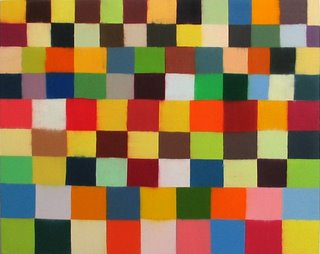 few years ago turned her attention to compositions with blocks of color, as if she’d distilled her world and organized it into neat little swatches. Wilson’s oil paintings in this show are small—8 x10 to 20 x 16 inches—with squares or rectangles organized into grids in which the uniformity of shape is broken by occasional feathering as one color leaches tentatively into another, or a skew of size or out-of-step placement. Green predominates. Or is it red? Or umber? There’s a lot of give and take there, but the work remains lyrical to my eyes.
few years ago turned her attention to compositions with blocks of color, as if she’d distilled her world and organized it into neat little swatches. Wilson’s oil paintings in this show are small—8 x10 to 20 x 16 inches—with squares or rectangles organized into grids in which the uniformity of shape is broken by occasional feathering as one color leaches tentatively into another, or a skew of size or out-of-step placement. Green predominates. Or is it red? Or umber? There’s a lot of give and take there, but the work remains lyrical to my eyes.
 few years ago turned her attention to compositions with blocks of color, as if she’d distilled her world and organized it into neat little swatches. Wilson’s oil paintings in this show are small—8 x10 to 20 x 16 inches—with squares or rectangles organized into grids in which the uniformity of shape is broken by occasional feathering as one color leaches tentatively into another, or a skew of size or out-of-step placement. Green predominates. Or is it red? Or umber? There’s a lot of give and take there, but the work remains lyrical to my eyes.
few years ago turned her attention to compositions with blocks of color, as if she’d distilled her world and organized it into neat little swatches. Wilson’s oil paintings in this show are small—8 x10 to 20 x 16 inches—with squares or rectangles organized into grids in which the uniformity of shape is broken by occasional feathering as one color leaches tentatively into another, or a skew of size or out-of-step placement. Green predominates. Or is it red? Or umber? There’s a lot of give and take there, but the work remains lyrical to my eyes. Helen Miranda Wilson, Grasshopper, oil on panel, 8 x 10 inches, 2006
 Down the street at the Ernden Gallery another artist whose work I like is represented: Carlos Estrada-Vega. He’s also working with blocks, and his scale is also modest. But whereas Wilson’s paintings are flat and relatively uninflected, Estrada-Vega’s are physically dimensional. Each painting is a relief composed of hundreds of individual canvas-covered blocks that he colors with wax paint (something he calls oleopasto) that are adhered onto a metal plate by means of tiny magnets embedded in each block. The work is called painting, but it’s also relief sculpture as the individual units vary by height. There’s so much going on—the topography, the colors in quiet or spirited conversation, and textures modulating the exchange.
Down the street at the Ernden Gallery another artist whose work I like is represented: Carlos Estrada-Vega. He’s also working with blocks, and his scale is also modest. But whereas Wilson’s paintings are flat and relatively uninflected, Estrada-Vega’s are physically dimensional. Each painting is a relief composed of hundreds of individual canvas-covered blocks that he colors with wax paint (something he calls oleopasto) that are adhered onto a metal plate by means of tiny magnets embedded in each block. The work is called painting, but it’s also relief sculpture as the individual units vary by height. There’s so much going on—the topography, the colors in quiet or spirited conversation, and textures modulating the exchange.
 Down the street at the Ernden Gallery another artist whose work I like is represented: Carlos Estrada-Vega. He’s also working with blocks, and his scale is also modest. But whereas Wilson’s paintings are flat and relatively uninflected, Estrada-Vega’s are physically dimensional. Each painting is a relief composed of hundreds of individual canvas-covered blocks that he colors with wax paint (something he calls oleopasto) that are adhered onto a metal plate by means of tiny magnets embedded in each block. The work is called painting, but it’s also relief sculpture as the individual units vary by height. There’s so much going on—the topography, the colors in quiet or spirited conversation, and textures modulating the exchange.
Down the street at the Ernden Gallery another artist whose work I like is represented: Carlos Estrada-Vega. He’s also working with blocks, and his scale is also modest. But whereas Wilson’s paintings are flat and relatively uninflected, Estrada-Vega’s are physically dimensional. Each painting is a relief composed of hundreds of individual canvas-covered blocks that he colors with wax paint (something he calls oleopasto) that are adhered onto a metal plate by means of tiny magnets embedded in each block. The work is called painting, but it’s also relief sculpture as the individual units vary by height. There’s so much going on—the topography, the colors in quiet or spirited conversation, and textures modulating the exchange. Carlos Estrada-Vega, Walt, oleopasto on canvas, 10 x 10 inches, 2005
I also saw the work of Boston-based Reese Inman at a terrific new gallery called Kobalt (no website yet, but the gallery info lists the URLas www.kobaltgallery.com, so presumably it’s coming). Kobalt took over the space that had been occupied by other galleries in past seasons. Director Francine D’Olympio has a keen eye and a strong program, and with gallery doors that open onto a brick patio that merges into the sidewalk, the space is not only visually inviting but physically beckoning as well.
 Inman works with the grid, but she defines each square with a dot. Specifically, she paints dots that have been arranged in logarithmically patterned formats. Working on a large-scale printout that she adheres to her painting surface, Inman builds up her surface dot by dot, color over color, often returning to sand away parts of those dots to reveal the edges of the color beneath. At the same time that the work feels twenty-first-century current, the sanding gives it a distinct archeological sensibility. Reese’s new series is called Maps, and the work suggests both the means to a destination and the destination itself. You can see more on her website. She’s also represented by Gallery Naga in Boston.
Inman works with the grid, but she defines each square with a dot. Specifically, she paints dots that have been arranged in logarithmically patterned formats. Working on a large-scale printout that she adheres to her painting surface, Inman builds up her surface dot by dot, color over color, often returning to sand away parts of those dots to reveal the edges of the color beneath. At the same time that the work feels twenty-first-century current, the sanding gives it a distinct archeological sensibility. Reese’s new series is called Maps, and the work suggests both the means to a destination and the destination itself. You can see more on her website. She’s also represented by Gallery Naga in Boston.
I also saw the work of Boston-based Reese Inman at a terrific new gallery called Kobalt (no website yet, but the gallery info lists the URLas www.kobaltgallery.com, so presumably it’s coming). Kobalt took over the space that had been occupied by other galleries in past seasons. Director Francine D’Olympio has a keen eye and a strong program, and with gallery doors that open onto a brick patio that merges into the sidewalk, the space is not only visually inviting but physically beckoning as well.
 Inman works with the grid, but she defines each square with a dot. Specifically, she paints dots that have been arranged in logarithmically patterned formats. Working on a large-scale printout that she adheres to her painting surface, Inman builds up her surface dot by dot, color over color, often returning to sand away parts of those dots to reveal the edges of the color beneath. At the same time that the work feels twenty-first-century current, the sanding gives it a distinct archeological sensibility. Reese’s new series is called Maps, and the work suggests both the means to a destination and the destination itself. You can see more on her website. She’s also represented by Gallery Naga in Boston.
Inman works with the grid, but she defines each square with a dot. Specifically, she paints dots that have been arranged in logarithmically patterned formats. Working on a large-scale printout that she adheres to her painting surface, Inman builds up her surface dot by dot, color over color, often returning to sand away parts of those dots to reveal the edges of the color beneath. At the same time that the work feels twenty-first-century current, the sanding gives it a distinct archeological sensibility. Reese’s new series is called Maps, and the work suggests both the means to a destination and the destination itself. You can see more on her website. She’s also represented by Gallery Naga in Boston. By the way, both Inman and Estrada-Vega are on the Geoform site.
Reese Inman, Map 1, acrylic on panel, 24 x 24", 2006
 Since I’ve been working blocks and bands for some years, I’m always interested to see how these and other other artists organize their geometry and how their palette integrates with the geometry. Indeed, "blocks of color" is a simple description, but the expression of the concept is infinitely varied and vast. And of course you are composing your HTML drawings with rows and blocks of color. (I love that the cut-and-paste mechanics of their making leads to to also think of them as collage.)
Since I’ve been working blocks and bands for some years, I’m always interested to see how these and other other artists organize their geometry and how their palette integrates with the geometry. Indeed, "blocks of color" is a simple description, but the expression of the concept is infinitely varied and vast. And of course you are composing your HTML drawings with rows and blocks of color. (I love that the cut-and-paste mechanics of their making leads to to also think of them as collage.)I'llI close with these few images of blocks from other other artists and cultures. Chris, feel free to add to the mix if you are so inclined.
Left: Paul Klee, Ancient Sound, 1925; and a painting, above, from 1935
Below: Mensie Lee Petway, Strips, pieced quilt, 2003
Left: Peruvian tapestry fragment
Right: Young monks in a Bhutan monastery facing a painted or tiled wall. The block pattern is very much like the the 1930s Amish quilt from Lancaster County, Pa., below
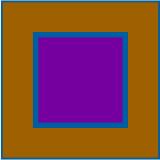
Below: Mondrian, Contexture, oil on canvas, 1930s; above: another 1930s Amish quilt. Do I need to comment on all the visual connections?

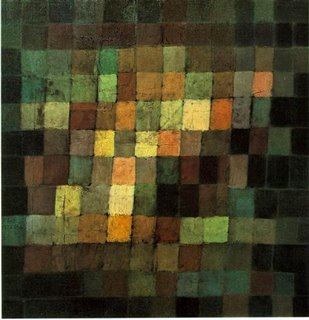
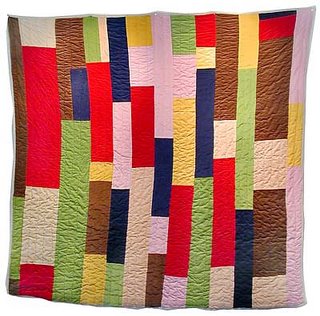
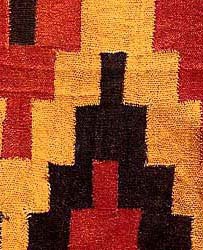
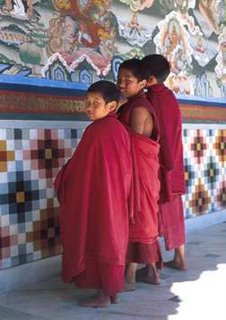
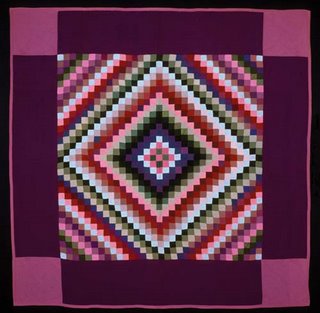
No comments:
Post a Comment